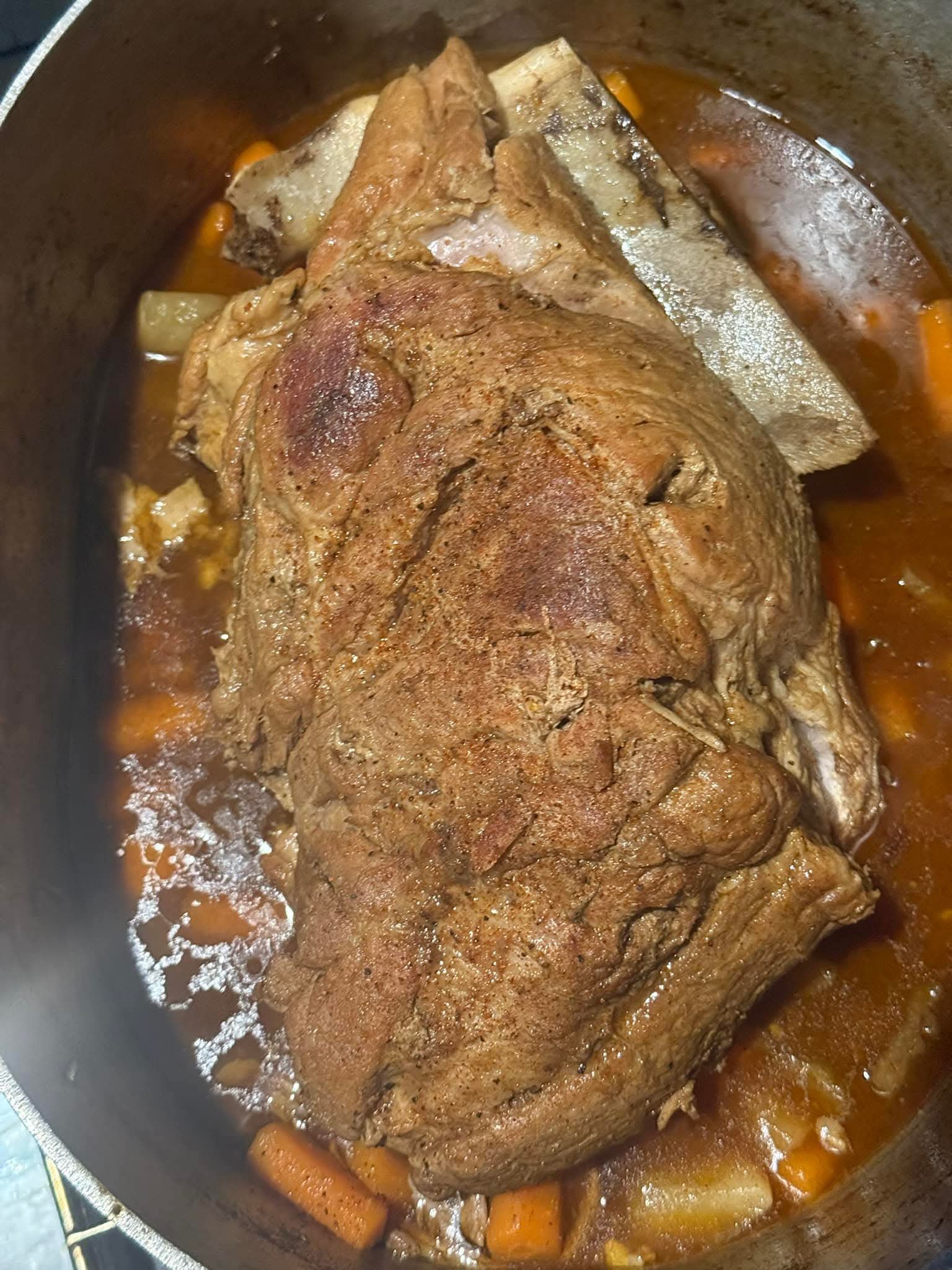
Few dishes conjure up images of cozy family dinners and comforting aromas quite like a classic Sunday Pork Roast. This recipe takes a humble pork butt and transforms it into a juicy, fork-tender masterpiece, surrounded by perfectly roasted vegetables infused with the sweet tang of apple juice and fresh rosemary. It’s the kind of meal that makes your house smell incredible and leaves everyone feeling satisfied and nourished. Get ready to embrace the warmth and ease of a truly spectacular roasted dinner!
Why I Love This Recipe
I’ve always believed that the best meals are often the simplest, especially when they deliver big on flavor. This Sunday Pork Roast is a testament to that philosophy. What I particularly love about it is the “set it and forget it” nature once it’s in the oven, allowing you to enjoy your Sunday while dinner practically cooks itself. The initial high-heat roast creates a beautiful crust, locking in the juices, while the longer, slow cook ensures the pork butt becomes incredibly tender and easy to shred. The combination of the savory pork, the sweet apple juice, and the earthy rosemary with the tender vegetables creates a harmonious flavor profile that is truly irresistible. It’s a complete meal in one pan, making cleanup a breeze, which is always a win in my book!
Ingredients
For the Roast:
- 3 to 5 pounds pork butt roast (also known as Boston butt or pork shoulder)
- 2 Tablespoons vegetable oil
- 2 teaspoons salt
- 2 teaspoons black pepper
- 1 teaspoon garlic powder
- 1 teaspoon onion powder
- 1 teaspoon paprika
For the Vegetables:
- 2 large white onions, cut into 2-inch chunks
- ½ pound baby carrots
- 1 pound red baby potatoes (or other small potatoes, halved)
- 2 cups apple juice (unsweetened is best)
- 1 sprig fresh rosemary (about 4-5 inches long)
Swaps and Notes
- Pork Cut: Pork butt (shoulder) is ideal for this slow-roasting method due to its marbling, which breaks down to create incredibly tender and juicy meat. You could use a boneless pork shoulder as well.
- Seasoning Rub: Feel free to adjust the spices to your preference. A pinch of cayenne pepper can add a little heat, or dried thyme could enhance the herbal notes.
- Vegetables: This recipe is very flexible with vegetables. You can add sweet potatoes, parsnips, celery, or even bell peppers for more variety. Just ensure they are cut into similar-sized chunks for even cooking.
- Apple Juice: Unsweetened apple juice is preferred as the sweetness will concentrate. You could also use chicken broth or a dry hard cider for a less sweet, more savory flavor.
- Rosemary: Fresh rosemary is highly recommended for its aromatic qualities. If you don’t have fresh, use ½ teaspoon of dried rosemary, crushed.
- Roasting Pan: A large cast iron Dutch oven or a sturdy roasting pan with a lid (even if you’re cooking uncovered, a lid is helpful for transport or resting) is perfect.
Instructions
- Preheat Oven: Begin by preheating your oven to a high temperature of 450°F (230°C). This initial high heat will create a beautiful crust on the pork.
- Prepare the Pork Roast: Pat your 3 to 5-pound pork butt roast thoroughly dry with paper towels. This helps the seasoning adhere and promotes better browning. Rub the entire surface of the roast with 2 tablespoons of vegetable oil.
- Season the Roast: In a small bowl, combine the 2 teaspoons of salt, 2 teaspoons of black pepper, 1 teaspoon of garlic powder, 1 teaspoon of onion powder, and 1 teaspoon of paprika. Stir these spices together until well blended. Generously sprinkle this seasoning mixture all over the pork roast, ensuring it’s well coated. Place the seasoned pork roast, fatty side up, in a large roasting pan or a cast iron Dutch oven.
- Initial High-Heat Roast: Roast the pork, uncovered, in the preheated 450°F (230°C) oven for 45 minutes. This step helps develop that desirable crispy exterior.
- Reduce Heat & Continue Roasting: After 45 minutes, reduce the oven temperature to 350°F (175°C). Continue cooking the pork roast for an additional 1 hour, still uncovered.
- Add Vegetables & Liquid: Remove the roast from the oven. Carefully arrange the cut onion chunks, baby carrots, and red baby potatoes around the meat in the roasting pan. Pour the 2 cups of apple juice over the vegetables. Place the fresh sprig of rosemary directly on top of the roast or nestled among the vegetables.
- Final Cook: Return the pan to the 350°F (175°C) oven and continue cooking for an additional 1 ½ hours, still uncovered. The roast is ready when the vegetables are tender when pierced with a fork, and the meat shreds easily with two forks. If you prefer, you can check the internal temperature of the pork, which should be at least 145°F (63°C) for slicing, but for shredding, it will be much higher (around 190-205°F or 88-96°C).
- Serve: Once cooked, remove the roast and vegetables from the oven. Season the vegetables with additional salt and pepper to taste if needed. Let the roast rest for 10-15 minutes before shredding or slicing. Serve hot, with the tender vegetables and pan juices.
Tips for Success
- Patience with Pork Butt: Pork butt benefits greatly from a longer cooking time at a lower temperature. Don’t rush it; the extra time allows the connective tissue to break down, resulting in incredibly tender meat.
- Fatty Side Up: Roasting with the fatty side up allows the fat to slowly render and baste the roast as it cooks, keeping the meat moist and flavorful.
- Don’t Skimp on Seasoning: A generous rub creates a flavorful crust.
- Internal Temperature for Shredding: While pork is safe to eat at 145°F, for pull-apart tender shredded pork, you’ll want it to reach an internal temperature between 190°F and 205°F (88-96°C).
- Resting Time: Always let your roast rest after cooking. This allows the juices to redistribute throughout the meat, ensuring it remains incredibly moist.
Serving Suggestions and Pairings
This Sunday Pork Roast is a complete meal in itself with the roasted vegetables. However, you can enhance it further with:
- A side of mashed potatoes (if you want more than just the roasted ones!) or creamy polenta to soak up the juices.
- A simple green salad with a light vinaigrette for freshness.
- Crusty bread for dipping into the delicious pan juices.
- A side of applesauce or cranberry sauce for a classic pairing.
For other hearty and flavorful main dishes, consider:
- My This Tomato Skillet with Okra and Sausage is My Favorite Quick Dinner Packed with Southern Flavor for another satisfying meal.
- A comforting bowl of This Cajun Chicken Sausage Gumbo is My Favorite Bowl of Southern Comfort.
Storage and Leftover Tips
Leftover pork roast and vegetables can be stored in an airtight container in the refrigerator for up to 3-4 days. To reheat, gently warm in the microwave or in a covered dish in the oven at 300°F (150°C) until heated through. The shredded pork is also fantastic for:
- Pork sandwiches or sliders
- Tacos or quesadillas
- Mixed into a casserole
- Added to soups or stews
More Recipes You Will Love
If you enjoyed the comforting and easy nature of this Sunday Pork Roast, you’ll love exploring some of these other fantastic main dishes:
- For another comforting meat dish, check out These Easy Turkey Wings are My Favorite Comfort Food for Lazy Sundays.
- If you’re into flavorful one-pan meals, my This Mexican Chicken and Rice Casserole is My Favorite One-Pan Dinner That’s Always a Hit is a must-try.
- And for a super convenient and tasty start to your day, my This One-Pan Breakfast Bake Will Make You Skip is fantastic.
Final Thoughts
This Sunday Pork Roast recipe is a timeless classic for a reason. It delivers incredibly flavorful, melt-in-your-mouth pork and perfectly tender vegetables, all with relatively hands-off cooking time. It’s the ultimate comfort food that’s perfect for feeding your family or preparing for meal prep throughout the week. Give it a try, and make your next Sunday dinner truly special!
What’s your favorite classic Sunday dinner? Share your traditions and tips in the comments below, and don’t forget to connect with Chef Maniac for more delicious and inspiring recipes!




Leave a Reply